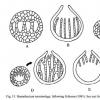
24-01-2014 16:59
 Godorova Olga
Godorova Olga
Hello, dear friends. I'd like to post pictures of

24-01-2014 02:19
Someone have this paper?Cain, R. F. 1962: Studies

22-01-2013 16:49
Hello dear friends of Asco France,any of you have

23-01-2014 20:15
 Zuzana Sochorová (Egertová)
Zuzana Sochorová (Egertová)
Nice evening to all Octospora fans :-)in October I

23-01-2014 16:41
Gina RackleyThe fruiting bodies are dark grey and round disc

20-01-2014 22:20
 Joop van der Lee
Joop van der Lee
Found on dung from calfs of Scottisch highlanders
The meaning of "trabeculate"
Björn Wergen,
28-01-2014 22:17
 Hi friends,
Hi friends,I have one question: what does the word "trabeculate" mean? Its mostly used to describe paraphyses/pseudoparaphyses. I have problems to decide whether the paraphyses are trabeculate or not...
In latin, trabecula means "beam". I think it could be the connections between the paraphyses/pseudoparaphyses?
Thanks in advance!
regards,
björn
Chris Yeates,
28-01-2014 23:51

Re : The meaning of "trabeculate"
From Dictionary of the Fungi:
"Hamathecium (Eriksson, Opera Bot. 60: 15, 1981), a neutral term for all kinds of hyphae or other tissues between asci, or projecting into the locule or ostiole of ascomata; usually of carpocentral origin; interascal tissues. Eriksson recognized seven categories (see Fig. 14A-F - below):
(A) Interascal pseudoparenchyma, carpocentral tissues unchanged or compressed between developing asci; e.g. Wettsteinina.
(B) Paraphyses, hyphae originating from the base of the cavity, usually unbranched and not anastomosed; e.g. Pyrenula, Xylaria.
(C) Paraphysoids (trabecular pseudoparaphyses; tinophyses), interascal or pre-ascal tissue stretching and coming to resemble pseudoparaphyses; often only remotely septate, anastomosing and very narrow (see Barr, Mycol. 71: 935, 1979); e.g. Patellaria, Melanomma.
. . . . . . . . "
regards
Chris
"Hamathecium (Eriksson, Opera Bot. 60: 15, 1981), a neutral term for all kinds of hyphae or other tissues between asci, or projecting into the locule or ostiole of ascomata; usually of carpocentral origin; interascal tissues. Eriksson recognized seven categories (see Fig. 14A-F - below):
(A) Interascal pseudoparenchyma, carpocentral tissues unchanged or compressed between developing asci; e.g. Wettsteinina.
(B) Paraphyses, hyphae originating from the base of the cavity, usually unbranched and not anastomosed; e.g. Pyrenula, Xylaria.
(C) Paraphysoids (trabecular pseudoparaphyses; tinophyses), interascal or pre-ascal tissue stretching and coming to resemble pseudoparaphyses; often only remotely septate, anastomosing and very narrow (see Barr, Mycol. 71: 935, 1979); e.g. Patellaria, Melanomma.
. . . . . . . . "
regards
Chris


